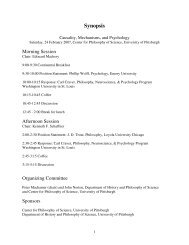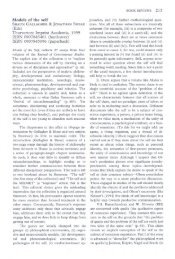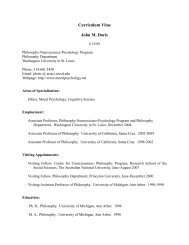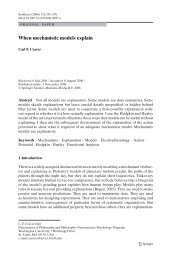The Blackwell Guide to the Philosophy of Science - The Department ...
The Blackwell Guide to the Philosophy of Science - The Department ...
The Blackwell Guide to the Philosophy of Science - The Department ...
Create successful ePaper yourself
Turn your PDF publications into a flip-book with our unique Google optimized e-Paper software.
Molecular and Developmental Biology<br />
study <strong>of</strong> selection at <strong>the</strong> phenotypic level – <strong>to</strong> proceed. Selection could be studied<br />
at <strong>the</strong> phenotypic level on <strong>the</strong> assumption that variant phenotypes were generated<br />
in some unknown way by <strong>the</strong> genes and that phenotypic change would be tracked<br />
by change in gene frequencies. Population genetics, <strong>the</strong> ma<strong>the</strong>matical core <strong>of</strong> <strong>the</strong><br />
modern syn<strong>the</strong>sis, could postulate genes corresponding <strong>to</strong> phenotypic differences<br />
and track <strong>the</strong> effect <strong>of</strong> selection on <strong>the</strong>se phenotypic variants at <strong>the</strong> genetic level.<br />
One effect <strong>of</strong> this strategy was <strong>to</strong> direct attention away from ideas that would<br />
obstruct <strong>the</strong>se research practices. Among <strong>the</strong>se inconvenient ideas was <strong>the</strong> view<br />
that development does not always permit <strong>the</strong> phenotypes that selection would<br />
favor. This idea was revived in <strong>the</strong> “punctuated equilibrium” <strong>the</strong>ory <strong>of</strong> Niles<br />
Eldredge and Stephen J. Gould (Eldredge and Gould, 1972; Gould and Eldredge,<br />
1977). Traditional neo-Darwinian gradualism suggests that species evolve more<br />
or less continuously in response <strong>to</strong> local selection pressures. <strong>The</strong> fossil record, on<br />
<strong>the</strong> o<strong>the</strong>r hand, suggests that species remain largely unaltered for long periods <strong>of</strong><br />
time and occasionally undergo dramatic periods <strong>of</strong> rapid evolutionary change. <strong>The</strong><br />
punctuated equilibrium <strong>the</strong>ory proposed that <strong>the</strong> fossil record be read at face value,<br />
ra<strong>the</strong>r than in <strong>the</strong> light <strong>of</strong> <strong>the</strong> gradualist model <strong>of</strong> evolution. <strong>The</strong> new <strong>the</strong>ory<br />
needed an evolutionary explanation <strong>of</strong> this pattern and sought it in “developmental<br />
constraints.” <strong>The</strong> range <strong>of</strong> variant phenotypes produced by genetic changes is constrained<br />
by <strong>the</strong> nature <strong>of</strong> <strong>the</strong> organism’s developmental system so that selection is<br />
usually unable <strong>to</strong> produce dramatic reorganization <strong>of</strong> <strong>the</strong> phenotype. Conversely,<br />
a relatively small genetic change might, in <strong>the</strong> context <strong>of</strong> development as a whole,<br />
result in large phenotypic changes and very rapid evolution. Both possibilities can<br />
be unders<strong>to</strong>od using C. H. Wadding<strong>to</strong>n’s metaphor <strong>of</strong> developmental canalization<br />
(Figure 12.1). Most small perturbations <strong>to</strong> <strong>the</strong> course <strong>of</strong> development are<br />
compensated so that <strong>the</strong> organism arrives at <strong>the</strong> same destination. Some, however,<br />
send development down an entirely new “channel.”<br />
A second source <strong>of</strong> <strong>the</strong> renewed interest in developmental constraint was <strong>the</strong><br />
debate over <strong>the</strong> limits <strong>of</strong> adaptive explanation. Stephen J. Gould and Richard<br />
Lewontin (1979) strongly criticized “adaptationism” – <strong>the</strong> practice <strong>of</strong> seeking<br />
adaptive explanations for every feature <strong>of</strong> organisms. <strong>The</strong>y suggested developmental<br />
constraint as one alternative explanation <strong>of</strong> biological form. <strong>The</strong>re are, for<br />
example, many viviparous snakes, but no viviparous turtles. Perhaps this is <strong>to</strong> be<br />
explained adaptively: any transitional form <strong>of</strong> turtle would be less fit that its fully<br />
oviparous competi<strong>to</strong>rs. <strong>The</strong> ease with which o<strong>the</strong>r groups, such as snakes and<br />
sharks, have evolved viviparous and quasi-viviparous species suggests an alternative<br />
explanation. Perhaps <strong>the</strong> developmental biology <strong>of</strong> turtles means that no<br />
mutation produces <strong>the</strong> transitional forms. Gould and Lewontin also revived <strong>the</strong><br />
traditional idea <strong>of</strong> <strong>the</strong> bauplan (body plan) or “unity <strong>of</strong> type” <strong>of</strong> a whole group<br />
<strong>of</strong> organisms. Crustaceans, for example, have <strong>the</strong> segmented body <strong>of</strong> o<strong>the</strong>r arthropods<br />
but are distinguished from o<strong>the</strong>r clades by <strong>the</strong> fusion <strong>of</strong> <strong>the</strong> first five segments<br />
<strong>to</strong> form a head. It seems unlikely that this character has been a critical<br />
component <strong>of</strong> <strong>the</strong> fitness <strong>of</strong> every crustacean, from lobster <strong>to</strong> barnacle, but it has<br />
remained stable through long periods <strong>of</strong> evolution. Perhaps this is <strong>to</strong> be explained<br />
255








